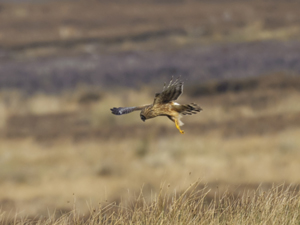 BASC says that including brood or nest management as part of the Hen Harrier Joint Recovery Plan will assist with the recovery of this iconic bird of prey in England.
BASC says that including brood or nest management as part of the Hen Harrier Joint Recovery Plan will assist with the recovery of this iconic bird of prey in England.
Under the oversight of Defra, the plan was drawn up by moor owners, gamekeepers and conservation groups. It is designed to boost hen harrier numbers in the English uplands without damaging the viability of grouse moors.
Work started in August 2012 and the plan – which comprises 6 inter-dependent elements – has been ready since January this year. It is not clear why it has not yet been officially launched.
BASC says there is no good conservation reason why one of the elements – brood or nest management – should not be included. In France and Spain the introduction of schemes that allow eggs to be collected (where there is genuine conflict with land use) and the chicks released some six weeks later, at designated releasing points, has ensured their birds of prey have thrived – because the root cause of illegal killing has been removed.
The principle of captive-rearing is well established and has been successfully used for a wide range of endangered species – as highlighted by the RSPB’s former Chairman of Council, Ian Newton, in his book Population Limitation in Birds. These schemes are so successful, in part, because captive-reared birds generally have better body condition and better post-fledging survival. Examples of species that have benefitted from captive rearing programmes are White-tailed Eagles and Red Kites in Britain, and Peregrine Falcons, Ospreys, Condors, Bald Eagles and Aplomado Falcons in Europe and America.
Alan Jarrett, chairman of the UK’s largest shooting organisation, The British Association for Shooting and Conservation (BASC), said: “Nest management is an internationally proven conservation technique, that helps achieve the recovery of threatened populations. From an international perspective brood management is part of this recovery package to ensure we have a thriving population of hen harriers in England.
“The time has come for Government to publish the plan. It was drawn up by all sides of the debate and is a sensible and sustainable way forward. It aims to deliver more hen harriers, but without damaging the grouse interests that fund essential moorland management.”
BASC is calling on all who care about shooting and conservation to sign an e-petition calling on the Government to publish the plan to increase the numbers of these birds in England.
Richard Ali, chief executive of BASC, said: “We applaud all those who have so far helped to bring the issue to a wider audience by signing the petition and encouraging others to do so and we are asking people to continue to support the petition and raise awareness of it so we can get this plan put into action.”
To view the petition, click here.
BASC has previously warned that calls for the licensing of grouse moors would have significant unintended consequences, causing a loss of valuable habitat and biodiversity and leading to unemployment and rural depopulation. For more information click here.
ENDS
Notes:
Brood or nest management is the supervised temporary removal of hen harrier chicks to aviaries. Some six weeks later fledged young are carefully released back into suitable habitat.
In August 2012, Defra officials established the Hen Harrier Sub-Group of the Uplands Stakeholder Forum including representatives from Natural England, the Moorland Association, the National Gamekeepers’ Organisation, the Game & Wildlife Conservation Trust, the National Park Authority and the RSPB. This group has produced a Hen Harrier Joint Recovery Plan. Defra is expected to make an announcement soon on whether the plan will go ahead.
Duncan Thomas, BASC’s North West regional officer, said: “I am delighted to announce that two of the English Hen Harriers nests on moorland where driven grouse shooting takes place have either fledged or will fledge in the next few days in Lancashire. With the full support of the shooting community, this is an enormous step forward in terms of evidencing the clear link between upland biodiversity and driven grouse shooting.”